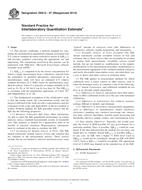Potrebujeme váš súhlas na využitie jednotlivých dát, aby sa vám okrem iného mohli ukazovať informácie týkajúce sa vašich záujmov. Súhlas udelíte kliknutím na tlačidlo „OK“.
ASTM D6512-07(2014)
Standard Practice for Interlaboratory Quantitation Estimate (Withdrawn 2023)
Automaticky preložený názov:
Štandardné praktiky pre kruhových kvantifikácie Odhad
NORMA vydaná dňa 15.1.2014
Informácie o norme:
Označenie normy: ASTM D6512-07(2014)
Poznámka: NEPLATNÁ
Dátum vydania normy: 15.1.2014
Kód tovaru: NS-35436
Počet strán: 15
Približná hmotnosť: 45 g (0.10 libier)
Krajina: Americká technická norma
Kategória: Technické normy ASTM
Kategórie - podobné normy:
Anotácia textu normy ASTM D6512-07(2014) :
Keywords:
critical limit, matrix effects, precision, quantitation, quantitation limit, ICS Number Code 03.120.20 (Product and company certification. Conformity assessment)
Doplňujúce informácie
| Significance and Use | ||||||||
|
5.1 Appropriate application of this practice should result in an IQE achievable by most laboratories properly using the test method studied. That is, most laboratories should be capable of measuring concentrations greater than IQE5.2 The IQE values may be used to compare the quantitation capability of different methods for analysis of the same analyte in the same matrix. The IQE is not an indicator of individual laboratory performance. 5.3 The IQE procedure should be used to establish the interlaboratory quantitation capability for any application of a method where interlaboratory quantitation is important to data use. The intent of the IQE is not to set reporting limits. |
||||||||
| 1. Scope | ||||||||
|
1.1 This practice establishes a uniform standard for computing the interlaboratory quantitation estimate associated with Z % relative standard deviation (referred to herein as IQEZ %), and provides guidance concerning the appropriate use and application. The calculations involved in this practice can be performed with DQCALC, Microsoft Excel-based software available from ASTM.2 1.2 IQEZ % is computed to be the lowest concentration for which a single measurement from a laboratory selected from the population of qualified laboratories represented in an interlaboratory study will have an estimated Z % relative standard deviation (Z % RSD, based on interlaboratory standard deviation), where Z is typically an integer multiple of 10, such as 10, 20, or 30, but Z can be less than 10. The IQE10 % is consistent with the quantitation approaches of Currie (1)3 and Oppenheimer, et al. 1.3 The fundamental assumption of the collaborative study is that the media tested, the concentrations tested, and the protocol followed in the study provide a representative and fair evaluation of the scope and applicability of the test method as written. Properly applied, the IQE procedure ensures that the IQE has the following properties: 1.3.1 Routinely Achievable IQE Value—Most laboratories are able to attain the IQE quantitation performance in routine analyses, using a standard measurement system, at reasonable cost. This property is needed for a quantitation limit to be feasible in practical situations. Representative laboratories must be included in the data to calculate the IQE. 1.3.2 Accounting for Routine Sources of Error—The IQE should realistically include sources of bias and variation that are common to the measurement process. These sources include, but are not limited to: intrinsic instrument noise, some “typical” amount of carryover error; plus differences in laboratories, analysts, sample preparation, and instruments. 1.3.3 Avoidable Sources of Error Excluded—The IQE should realistically exclude avoidable sources of bias and variation; that is, those sources that can reasonably be avoided in routine field measurements. Avoidable sources would include, but are not limited to: modifications to the sample; modifications to the measurement procedure; modifications to the measurement equipment of the validated method, and gross and easily discernible transcription errors, provided there was a way to detect and either correct or eliminate them. 1.4 The IQE applies to measurement methods for which calibration error is minor relative to other sources, such as when the dominant source of variation is one of the following: 1.4.1 Sample Preparation, and calibration standards do not have to go through sample preparation. 1.4.2 Differences in Analysts, and analysts have little opportunity to affect calibration results (as is the case with automated calibration). 1.4.3 Differences in Laboratories (for whatever reasons), perhaps difficult to identify and eliminate. 1.4.4 Differences in Instruments (measurement equipment), such as differences in manufacturer, model, hardware, electronics, sampling rate, chemical processing rate, integration time, software algorithms, internal signal processing and thresholds, effective sample volume, and contamination level. 1.5 Data Quality
Objectives—Typically, one would compute the lowest % RSD
possible for any given dataset for a particular method. Thus, if
possible, IQE10 % would be computed. If the
data indicated that the method was too noisy, one might have to
compute instead IQE20 %, or possibly
IQE
Standard Practice for Determination of
Precision and Bias of Applicable Test Methods of Committee D19 on
Water Adjunct to D7510 Standard Practice for
Performing Detection and Quantitation Estimation and Data
Assessment Utilizing DQCALC Software, based on ASTM Practices D6091
and D6512 of Committee D19 on Water and D2777 Standard Practice for
Determination of Preci Standard Guide for Interpretation and Use
of Results from Interlaboratory Testing of Chemical Analysis
Methods (Withdrawn 2015) DQCALC Microsoft Excel-based software for the
Interlaboratory Quantitation Estimate (IQE) |
Odporúčame:
Aktualizácia technických noriem
Chcete mať istotu, že používate len platné technické normy?
Ponúkame Vám riešenie, ktoré Vám zaistí mesačný prehľad o aktuálnosti noriem, ktoré používate.
Chcete vedieť viac informácií ? Pozrite sa na túto stránku.




 Cookies
Cookies
